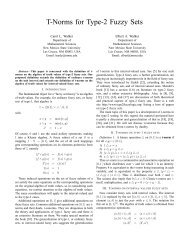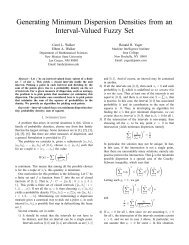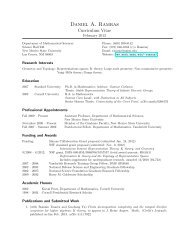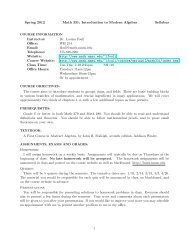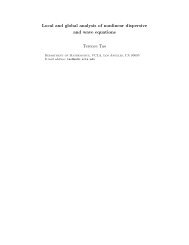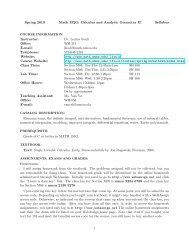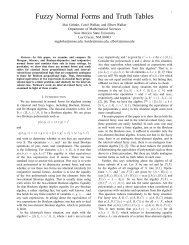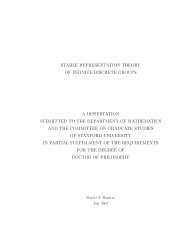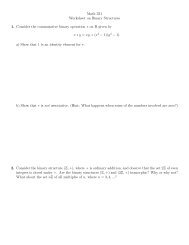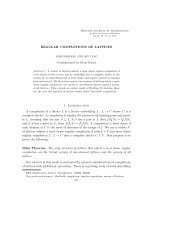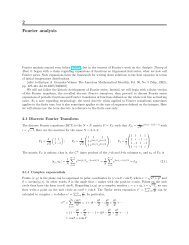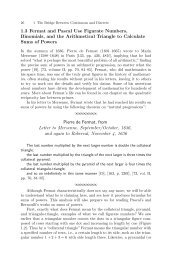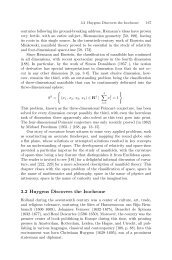Midterm Examination Review MATH 210G Fall, 2012 Instructions ...
Midterm Examination Review MATH 210G Fall, 2012 Instructions ...
Midterm Examination Review MATH 210G Fall, 2012 Instructions ...
You also want an ePaper? Increase the reach of your titles
YUMPU automatically turns print PDFs into web optimized ePapers that Google loves.
<strong>Midterm</strong> <strong>Examination</strong> <strong>Review</strong><br />
<strong>MATH</strong> <strong>210G</strong> <strong>Fall</strong>, <strong>2012</strong><br />
<strong>Instructions</strong>:<br />
You will be expected to SHOW WORK to justify your solutions.<br />
1. Answer each of the statements as true or false<br />
There will be a problem on the midterm with ten true/false items taken directly from<br />
the clicker quizzes.<br />
2. • Figure 1 shows histograms of heights of randomly chosen individuals from two<br />
different countries. In one of the countries, both males and females were measured.<br />
In the other country, only males were measured. Please indicate which of country<br />
A or country B you believe to be the one in which only males were measured, and<br />
briefly indicate the reason(s) for your beliefs.<br />
120<br />
100<br />
80<br />
60<br />
40<br />
20<br />
0<br />
155 160 165 170 175 180 185 190 195 200 205<br />
(a) country A<br />
200<br />
180<br />
160<br />
140<br />
120<br />
100<br />
80<br />
60<br />
40<br />
20<br />
0<br />
125 130 135 140 145 150 155 160 165<br />
(b) country B<br />
Figure 1:
• The following plot is a histogram of heights of 100 males solicited on a street<br />
corner in Amsterdam, rounded to the nearest even centimeter. Compute the<br />
mean, median, and variance of this data, rounded to the nearest centimeter.<br />
18<br />
16<br />
14<br />
12<br />
10<br />
8<br />
6<br />
4<br />
2<br />
0<br />
167 169 171 173 175 177 179 181 183 185 187 189 191 193 195 197 199<br />
Figure 2: Heights of random males in Amsterdam<br />
• The following plot is a histogram of heights of 100 females solicited at a shopping<br />
mall in Tokyo, rounded to the nearest even centimeter. Compute the mean,<br />
median, and variance of this data, rounded to the nearest centimeter.<br />
12<br />
10<br />
8<br />
6<br />
4<br />
2<br />
0<br />
129 131 133 135 137 139 141 143 145 147 149 151 153 155 157 159 161 163 165 167 169 171 173 175<br />
Figure 3: Heights of random females in Tokyo
3. The 36 possible outcomes of rolling a pair of dice are given by the ordered pairs in the<br />
following table. Each outcome is equally likely to happen.<br />
(1, 1) (1, 2) (1, 3) (1, 4) (1, 5) (1, 6)<br />
(2, 1) (2, 2) (2, 3) (2, 4) (2, 5) (2, 6)<br />
(3, 1) (3, 2) (3, 3) (3, 4) (3, 5) (3, 6)<br />
(4, 1) (4, 2) (4, 3) (4, 4) (4, 5) (4, 6)<br />
(5, 1) (5, 2) (5, 3) (5, 4) (5, 5) (5, 6)<br />
(6, 1) (6, 2) (6, 3) (6, 4) (6, 5) (6, 6)<br />
a) What is the probability that the sum of the dice will be 7 or 11<br />
b) What is the probability that the sum of the dice will be an even number<br />
c) What is the probability that the sum of the dice will be divisible by 3<br />
d) What is the probability that the sum of the dice will be divisible by 5<br />
e) What is the probability that the sum of the dice will be larger than six<br />
f) What is the probability that the both dice will be the equal
4. a) In three card guts, a hand consists of three cards dealt from a deck of 52 cards.<br />
How many distinct three card guts hands are there<br />
b) How many three card guts hands contain three of a kind<br />
c) How many three card guts hands contain a pair (but not three of a kind)<br />
d) How many three card guts hands do not contain any pairs<br />
e) How many three card guts hands do not contain any pairs but have an ace as the<br />
highest card<br />
f) How many three card guts hands have all cards in the same suit<br />
g) How many three card guts hands contain a straight, e.g., A, K, Q or J, 10, 9 or 3,<br />
2, A
5. • Two new students are assigned as roommates in a college dorm. Neither wants<br />
the bottom bunk bed. They decide each to pick one card from a deck of 52 cards.<br />
What is the probability that they will have a tie (Hint: this is the number of<br />
ways of drawing a pair from a deck of 52 cards, divided by the total number of<br />
ways of drawing two cards from a deck of 52 cards.)<br />
• Three roomates have to share a room with a triple bunk bed. They decide to<br />
draw cards from a deck of 52 cards. The mate who draws the highest card gets<br />
first dibs, then the next highest card, etc. What is the probability that they will<br />
all tie What is the probability that they will all draw cards of different ranks<br />
What is the probability that two will tie but the other will win<br />
• Four frat boys decide they will each draw a card from a deck of 52. The one who<br />
draws the lowest card gets his head shaved. In the case of a tie, those who tie<br />
for the low card each get their heads shaved. What is the probability that they<br />
will all get their heads shaved (this is the same as the number of ways to draw<br />
four cards all of equal rank, from a deck of 52, divided by the number of four<br />
card hands). What is the probability that exactly two will have to get their heads<br />
shaved<br />
• A frat house has exactly twenty six members. They play a game where each<br />
frat brother draws a card from a deck of 52. The one(s) with the lowest ranking<br />
card(s) have to get his (their) head(s) shaved. What is the minimum number of<br />
frat brothers who get their heads shaved What is the probability that only one<br />
of the frat boys gets his head shaved What is the most likely number of frat<br />
boys who will get their heads shaved
6. a) Starting with the first 4 rows of Pascal’s triangle, compute the next seven rows.<br />
1<br />
1 1<br />
1 2 1<br />
1 3 3 1<br />
b) How many distinct subsets are there of a set having ten elements In general, how<br />
many distinct subsets are there of a set having N elements Hint: consider the cases<br />
N = 0, 1, 2, 3 and look for a pattern. The set containing no elements is called the<br />
empty set. The empty set is a subset of every set. In particular, the empty set has<br />
one subset and a set with one element has two distinct subsets: the empty set and the<br />
element itself.<br />
c) Ten kids want to play a game of basketball. How many distinct ways are there to<br />
divide the kids into two teams each with five players<br />
d) How many distinct ways are there to divide the kids into two teams each with at<br />
least one player, and all other players on the other team
7. • Translate each sentence into an implication of the form A → B or˜B →˜A, then<br />
determine the intended implication of the following statements:<br />
Good poker players cannot be trusted<br />
People who wear fancy shoes are not lucky in love.<br />
Everyone is good in poker except nerds.<br />
You can trust people who wear shabby shoes.<br />
• Translate each sentence into an implication of the form A → B or˜B →˜A, then<br />
determine the intended implication of the following statements:<br />
No shark ever doubts that he is well fitted out.<br />
A fish, that cannot dance a minuet, is contemptible.<br />
No fish is quite certain that it is well fitted out, unless it has three rows of teeth.<br />
All fishes, except sharks, are kind to children.<br />
No heavy fish can dance a minuet.<br />
A fish with three rows of teeth is not to be despised.<br />
• Translate each sentence into an implication of the form A → B or˜B →˜A, then<br />
determine the intended implication of the following statements:<br />
No kitten that loves fish is unteachable.<br />
No kitten without a tail will play with a gorilla.<br />
Kittens with whiskers always love fish.<br />
No teachable kitten has green eyes.<br />
No kittens have tails unless they have whiskers.<br />
• Translate each sentence into an implication of the form A → B or˜B →˜A, then<br />
determine the intended implication of the following statements:<br />
Animals that do not kick are always unexcitable.<br />
Donkeys have no horns.<br />
A buffalo can always toss one over a gate.<br />
No animals that kick are easy to swallow.<br />
No hornless animal can toss one over a gate.<br />
All animals are excitable, except buffalo.<br />
• Translate each sentence into an implication of the form A → B or˜B →˜A, then<br />
determine the intended implication of the following statements:<br />
All who neither dance on tightropes nor eat penny-buns, are old.<br />
Pigs that are liable to giddiness are treated with respect.<br />
A wise balloonist takes an umbrella with him.<br />
No one ought to lunch in public, who looks ridiculous and eats penny-buns.
Young creatures who go up in balloons are liable to giddiness.<br />
Fat creatures who look ridiculous may lunch in public, provided they do not dance<br />
on tightropes.<br />
No wise creatures dance on tightropes, if liable to giddiness.<br />
A pig looks ridiculous carrying an umbrella.<br />
All who do not dance on tightropes, and who are treated with respect, are fat.<br />
• Translate each sentence into an implication of the form A → B or˜B →˜A, then<br />
determine the intended implication of the following statements:<br />
No Acrobatic feats, that are announced in the bill of Circus, are ever attempted<br />
there.<br />
No acrabatic feat is possible, if it involves turning in a quadruple somersault.<br />
No impossible acrobatic feat is ever announced in a circus bill.
8. • Fill in the values T or F for each of the rows and columns of the following truth<br />
table.<br />
Table 1: Logic truth table 1<br />
P Q P → Q (P → Q) ∧ P ((P → Q) ∧ P ) → Q<br />
T T<br />
T F<br />
F T<br />
F F<br />
• Fill in the values T or F for each of the rows and columns of the following truth<br />
table.<br />
Table 2: Logic truth table 2<br />
P Q R (P ∧ Q) (P ∧ R) (P ∧ Q) ∨ (P ∧ R) (P ∧ Q) ∨ (P ∧ R) ∨ (Q ∧ R)<br />
T T T<br />
T T F<br />
T F T<br />
T F F<br />
F T T<br />
F T F<br />
F F T<br />
F F F
• Fill in the values T or F for each of the rows and columns of the following truth<br />
table.<br />
Table 3: Logic truth table 3<br />
P Q R (P ∨ Q) (P ∨ R) (Q ∨ R) (P ∨ Q) ∧ (P ∨ R) (P ∨ Q) ∧ (P ∨ R) ∧ (Q ∨ R)<br />
T T T<br />
T T F<br />
T F T<br />
T F F<br />
F T T<br />
F T F<br />
F F T<br />
F F F



